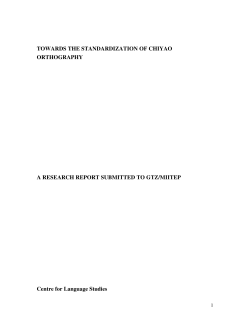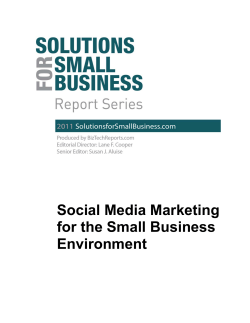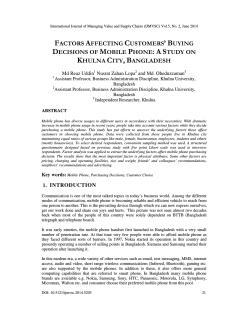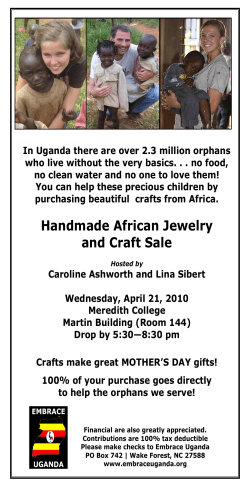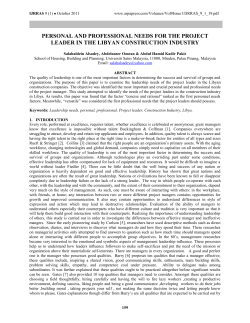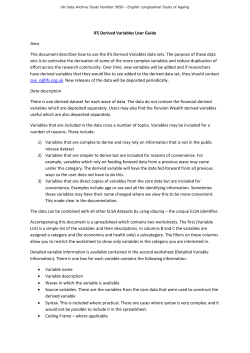
I Information on Female Genital Cutting: An Assessment (July 2004)
Information on Female Genital Cutting: What Is Out There? What Is Needed? An Assessment (July 2004) n response to an expressed need by the Female Genital Cutting (FGC) Interagency Working Group of the U.S. Agency for International Development (USAID), five collaborating agencies have worked over the last year to answer the question: what information exists on female genital cutting and what information gaps are perceived by individuals and groups that work to eradicate this practice? I The participants in the information gathering and assessment included: ■ Population Reference Bureau—Nancy Yinger and Charlotte FeldmanJacobs ■ Family Health International—Rose Wilcher and Kathleen Shears ■ PATH—Mary Ellsberg ■ Population Council — Laura Raney, Joanne Gleason; (Washington Office); Barbara Ibrahim and Mona Bur (West Asia and North Africa Regional Office in Cairo); and Nafy Diop (Sub-Saharan Africa Region, Dakar office) ■ The Manoff Group—Laurie Krieger and Amy Pearson Methodology Information was gathered for this report in three ways: 1. In-country questionnaires—The collaborating agencies collected information for this assessment in the following African countries where FGC is practiced: Burkina Faso, Egypt, Ethiopia, Guinea, Kenya, Mali, Senegal, and Uganda. Through a variety of methods—including face-toface interviews, emails, and focus groups—individuals working to eradicate FGC in these countries were asked about their use of FGC information resources as well as what they believe to be the gaps in resources. (See Appendix 1 for sample of questionnaire.) 2. Survey Monkey—This innovative Internet survey tool was used by PRB to gather information from nearly 100 respondents. These respondents included representatives from government agencies, NGOs, academic institutions, and bilateral or multilateral organizations. The survey was emailed to a wide audience culled from lists provided by the IGWG, PRB, INTACT, USAID (missions), and Wallace Global Fund (donors). Again, respondents were asked about the information resources they use as well as perceived gaps in information. (See Appendix 3 for Survey Monkey questionnaire.) 3. Website review—The five collaborating organizations reviewed 29 websites and databases that were identified as containing information on FGC. The sites were evaluated using a questionnaire prepared by Information on Female Genital Cutting: What is Out There? What is Needed? Table of Contents Methodology..................................1 Who Were the Respondents?.......2 Where Do They Get Their Information? ..................................2 Information Gaps..........................2 Where Are the Gaps?....................3 Review of Websites.......................3 Recommendations ........................4 Appendix I In-Country Questionnaires ..........6 Appendix II In-Country Organizations and Individuals .....................................8 Appendix III Survey Monkey Questionnaire and Results ..................................15 Appendix IV Review of FGC Websites ...........18 1 PRB. Reviewers examined the availability of FGC information on each site, the amount of coverage, and how easy it is to find the information. Each site was assessed on the timeliness of its information, accessibility to the audience, and overall presentation. (See Appendix 4 for sample of evaluation form.) Who Were the Respondents? In total, there were 288 survey respondents (98 via Survey Monkey and 186 in-country). The in-country questionnaires were administered to respondents in the eight countries mentioned. In April and May 2004, Population Council administered the questionnaires to 22 associations or individuals in Burkina Faso, 28 in Egypt, four in Guinea, and 16 in Senegal. The majority of the respondents in these countries are representatives of NGOs involved mainly in community-based work and behavior change communication programs related to FGC. The fewest number of responses received were from organizations involved in health care service delivery and the media. In all four countries, the majority of activities are conducted at the country and community level as opposed to regional or global. In Kenya, Family Health International (FHI) administered the questionnaire to 39 associations and individuals, receiving responses from 14 associations or individuals, the majority of whom represent NGOs. Most of the organizations conduct programs in policy advocacy and in behavior change communication at the community and country level. PATH administered questionnaires to 24 organizations and indi- viduals in Ethiopia, 26 in Mali, and 27 in Uganda. In Ethiopia, respondents are equally divided between NGOs and government organizations. The majority work in health care service delivery – though there were respondents who work in behavior change communication (BCC), community-based work, and policy advocacy, operating at the community and country level as well as regionally. In Mali, the respondents are with NGOs working on public health issues, predominately on BCC and community-based work, with half doing policy advocacy, and a quarter working on operations research and on prevalence. In Uganda, respondents are from NGOs working on public health issues, with virtually all of them working on BCC, with community-based work and policy advocacy following closely behind. Most of their work is at the community level. The same questionnaire was made available electronically, via the Internet tool Survey Monkey. An invitation to respond to the survey was sent by e-mail to a large sample of potential respondents, including USAID mission health officers, collaborating agencies in the U.S. and overseas, in addition to being posted for several weeks on several web sites and listservs. Of the 98 respondents who filled out the questionnaire using the Internet tool Survey Monkey, over half (51%) work for NGOs, with the rest spread among government agencies (17%), university or research institutions (14%), multilateral or bilateral organizations (10%), or the private sector or other (8%). In terms of the type of work they do, the majority conduct programs in communitybased work (56%), in BCC (50%), behavioral or social science research (43%), or in policy advo- Information on Female Genital Cutting: What is Out There? What is Needed? cacy (41%). Fewer respondents work in operations research (26%), measuring prevalence (16%), or health care service delivery (23%). Almost two-thirds report that they work at the country level (61%), but also at the community (52%), international (32%), and regional levels (21%). Where Do They Get Their Information? The second part of the survey asked respondents how they get the information they need on FGC – their organization’s library, other organization’s library, web searches, listservs (e-mail), face to face, or other. About 83 percent of Survey Monkey respondents said they get the information they need regarding FGC from printed materials from research or advocacy groups. The next two most popular resources were via web searches (69%) and through symposiums, conferences or workshops (62%). Information was also obtained from face-to-face encounters (59%), libraries (43%), or listservs (34%). (Note: The Survey Monkey questionnaire listed more options here than the in-country questionnaires, which did not list printed materials from research or advocacy groups, symposiums, conferences, and workshops.) In-country respondents from each of the eight countries reported that their most common source of information on FGC was through face-to-face communications. Least popular in most countries is the listserv method. Libraries and web searches fell in between. Information Gaps In May 2004, the five collaborating agencies met at PRB to compare and evaluate their findings. After 2 examining the collected data, the groups were able to draw some conclusions about access and gaps in information. Access: While a large percentage of Survey Monkey respondents stated that they do not have much difficulty in accessing information over the Internet (42% gave it a “1” on a scale of 1 to 5 with 1 being the easiest), most of them (63%) still prefer print materials to electronic materials. In Burkina Faso, Egypt, Guinea, and Senegal, most respondents said they find it relatively easy to access information on the Internet, but nearly all participants prefer print to electronic material. In Kenya, respondents were split on ease of access to information on the Internet (an average difficulty of 2.5 on a scale of 1 to 5) as well as their preference for print or electronic materials (six of the respondents prefer print materials to electronic materials, four prefer electronic, and four had no preference). In Uganda, respondents found it quite difficult to access the Internet (nearly 4 on a scale of 1 to 5); in Ethiopia, respondents found it a bit less difficult to access information on the Internet (3.4 on a scale of 1 to 5); and in Mali respondents found it even easier (2.2). In Uganda most preferred print materials (22 out of 29). (No information was collected on preference of print or electronic materials in Mali or Ethiopia.) Where Are the Gaps? In an attempt to clearly identify whether there are gaps and what types of gaps there are, we asked this question on Survey Monkey in many ways: how do respondents get the information they need, how easy is it to access information over the Internet, for what types of information do they need to have better access, do they believe there are information gaps, and what are they? An overwhelming number of Survey Monkey respondents (85%) said they do believe information gaps exist. And the top three types of information that they identified as most needed (on a scale of 1 to 5, with 5 being “desperately need it to be better, more accessible”) are best practices/evaluation results, advocacy tools, and statistical information. These were followed closely by training manuals and by case studies. This pattern is also born out by the open-ended question: What are the gaps? While many people mentioned a variety of information gaps—on prevalence, on projects that involve men, on networking, legislative data, medical resources and reconstructive surgery, on alternative jobs for circumcisers, etc.—by far the areas mentioned most were: best practices, success stories, and evaluated operations research. (See Survey Monkey, http://www. surveymonkey.com/Report.asp?U=4 3466451127, question #10 for detailed, open-ended responses on “what are the gaps.”) In-Country Data on Gaps: Generally, the in-country findings on information gaps (with the exception of Mali) were consistent with the Survey Monkey findings. Respondents expressed an overwhelming belief that there are information gaps and that more information is needed, especially on best practices/evaluation results, operations research results, training manuals, and advocacy tools. Nearly all respondents in Burkina Faso, Guinea, Senegal, and Information on Female Genital Cutting: What is Out There? What is Needed? Egypt believe that there are FGC information gaps. The most needed type of FGC information in Burkina Faso, Guinea, and Senegal is operations research results. In Egypt, it is best practices/evaluation results, but followed closely by case studies, training manuals, advocacy tools, links to other organizations, operations research results, and statistical information. Least required among respondents in all four countries is FGC policy-in-country. In Kenya, 12 of the 14 respondents feel there are information gaps. The number one type of information for which they would like more information is training manuals and support materials, followed closely by best practices/evaluation results and, third, by advocacy tools. In Ethiopia and in Uganda, respondents are almost unanimous in their belief that there are information gaps (23 of 24 in Ethiopia, and 25 of 27 in Uganda). Mali, however, was split, with 10 responding “yes” there are gaps and 15 saying there are not. In Ethiopia, the types of information most desired are operations research as well as advocacy tools, followed by best practices/evaluation results. In Uganda, significantly better access is desired of almost every type of information mentioned, but number one is operations research information, followed by training manuals and other support materials, and then a tie between links to other organizations and advocacy tools. (No information was collected in Mali on types of information desired.) Review of Websites: What Is Out There The participating NGOs had determined from the outset that it would not be enough to stop with what are 3 the “perceived” needs and gaps. We wanted to look at what is available in various websites to see if the information is out there but not widely known. Thus, the group also assessed 29 websites and databases identified as containing information on FGC. What we found was that, while there are some good resources out there, they do not fill the knowledge needs. There are many reasons for this: they are difficult to find, not well advertised, not easy to navigate, not comprehensive, and, perhaps most common, not updated regularly. Many of the groups that are readily identified with working on eradication of FGC (for example, Rainbo or InterAfrican Committee) have websites that need to be further developed or updated regularly. ORC Macro’s Demographic and Health Surveys site has very good datasets on FGC, yet, surprisingly, one of the “information needs” respondents mentioned was for more statistical information. This could be because people just don’t know about the site or don’t know how to use it, or perhaps it has more to do with having limited access to the Internet. Moreover, while some sites are noteworthy (see below), there does not appear to be one definitive site for FGC—one site might do a good job on prevalence, another on links to organizations, another on defining the different types of FGC, and yet another on their particular success story, but no one site seems to do it all. (See Appendix 4 for the grid used to compile information on websites, for the sites analyzed, and a table summarizing site content.) Three websites were given high “marks” in reviews by the collaborating organizations: those of the Intact Network, the Reproductive Health Gateway, and Gesellschaft für Technische Zusammenarbeit (GTZ). Criteria included type of information, ease of use, and frequency of updates. 1. Intact Network – International Network to Analyze, Communicate, and Transform the Campaign against FGC/FGM/FC The mission of the International Network to Analyze, Communicate and Transform the Campaign against Female Genital Cutting (INTACT), based in Cairo, is to promote and disseminate evidencebased research and to actively engage donors and local actors -governments and civil society organizations -- in a dialogue around applying collective learning to accelerate positive social change. ■ ■ ■ ■ ■ Information is relatively current Links to FGC-specific projects at local level Message Board to engage global dialogue Developing an Arabic Language Site Announces regional training courses ■ ■ ■ ■ Best search engine reviewed for FGC documents Information is relatively current Able to search FGC specific information from main page Pulls information from a wide variety of sources 3. Gesellschaft für Technische Zusammenarbeit (GTZ) “Since May 1999, a GTZ supraregional project has been supporting and promoting action groups campaigning for the abolition of female genital mutilation.” ■ ■ ■ ■ Site includes information in English and French Up-to-date information included fact sheets by country Describes approaches used by partner organizations Downloadable documents include monitoring and evaluation, qualitative, and quantitative information While determined to be the three “best available websites,” even these sites would benefit from technical assistance in organizing their sites, updating them, facilitating navigation, and marketing them. 2. Reproductive Health Gateway “Relevant, reliable information for reproductive health professionals. Search through specifically selected websites. Your queries are answered with links straight to the information you seek.” Information on Female Genital Cutting: What is Out There? What is Needed? 4 Recommendations Based on this compilation of information, the following recommendations are proposed by the collaborating agencies: Better Dissemination of Information. Two proposed vehicles to improve dissemination of FGC information are: ■ Production of a CD-ROM that compiles currently available information on FGC, including statistical data, a list of organizations working in FGC, a list of existing programs and project reports, relevant websites, etc. This would address the problem of availability and expense of Internet connections in developing countries. ■ Collaboration with HIPNET (the Health Information and Publications Network), a group of organizations who work with USAID on information dissemination. Operations Research. Since most in-country respondents asked for more information on operations research, an intense effort should be made on the part of USAID to collect information on existing OR projects and they should be included on the CD-ROM mentioned above. Best Practices. Support the collection and dissemination of information on FGC best practices or lessons learned. This can be fulfilled through: ■ A printed publication on success stories--this would be a compilation of a “good” (evaluated) set of project reports, either similar to the IGWG “So What” report or possibly a folder or binder containing a series of these success stories, identified by country or region. ■ One or more of the existing websites should publish these best practices in an easily accessible format and they should be widely marketed. Face-to-Face Information Exchanges. Work with various organizations, such as Rainbo or InterAfrican Committee, to organize national or regional symposia for these types of information exchanges; work with the Cairobased INTACT network via their incountry researchers. Focus also on facilitation of better networking among in-country organizations. Policy Information. Produce a short (4-6 pages) brief aimed at policy audiences and drawing from the success stories in the longer print publication mentioned above. Improved Websites and Information Dissemination. In response to the website reviews and to the surveys which indicate that the information that does exist is not getting out there, USAID and CAs could undertake: ■ Technical support for websites that have an important role to play in disseminating FGC information. ■ A marketing effort to disseminate information about available statistical sites and about the new FGC CD-ROM that has been produced by MEASURE DHS. For more information about this report, contact Charlotte Feldman Jacobs at Population Reference Bureau: [email protected] Information on Female Genital Cutting: What is Out There? What is Needed? 5 APPENDIX I In-country Questionnaires Questionnaire for Groups and Individuals Working on FGC This questionnaire is being circulated by ________________ (name of group) in order to gather information on the scope of existing information on female genital cutting (FGC). We are interested in learning what information and tools are being used by individuals and groups working on FGC, and on what information gaps need to be addressed. Name of Individual/Organization _____________________________________________________________________ What kind of organization do you work for (NGO, media, Ministry of Health, etc.)? ____________________ What type of work are you doing related to FGC? ■ Operations research ■ Measuring prevalence ■ Behavioral or social science research ■ Health care service delivery ■ Conducting programs in ___ policy advocacy ___ community-based work ___ behavior change communication (bcc) ■ Other: ___________________________________________________________________________________________ At what level is most of your work? ■ International ■ Regional ■ Country ■ Community How do you get the information you need on FGC? ■ Organization’s own library ■ Web searches ■ Listservs ■ Other organizations’ libraries ■ Face to face ■ Other ____________________________________________________________________________________________ How easy is it for you to access information over the Internet? (1=easy, 5=difficult) 1 2 3 4 5 Do you prefer print materials to electronic materials? ■ YES ■ NO Information on Female Genital Cutting: What is Out There? What is Needed? 6 APPENDIX I (continued) Of the various types of information you access, rate each type as to how critical it is for you to get better access (1= can now get it easily or don’t really need more, 5=desperately need it to be better, more accessible) A. Operations research results 1 2 3 4 5 B. Statistical or prevalence information 1 2 3 4 5 C. Training manuals and other support materials 1 2 3 4 5 D. Advocacy tools 1 2 3 4 5 E. Best practices/evaluation results 1 2 3 4 5 F. Case studies 1 2 3 4 5 G. Information on FGC policy in-country 1 2 3 4 5 H. Links to other organizations 1 2 3 4 5 Do you think there are information gaps ■ YES ■ NO If yes, how would you like to see the information gaps filled? _________________________________________ _____________________________________________________________________________________________________ _____________________________________________________________________________________________________ _____________________________________________________________________________________________________ Information on Female Genital Cutting: What is Out There? What is Needed? 7 APPENDIX II In-Country Organizations and Individuals List of Organizations and Individuals Queried By Country Burkina Faso No. 01 02 03 04 05 06 07 08 09 10 11 12 13 14 15 16 17 18 19 20 21 22 Organization G.T.Z DEMP ( Direction de l’éducation en matière de population) RECIF/ONG Musée Nationale Association Burkinabè des sages femmes UNICEF CROIX ROUGE Direction de la santé de la famille (DSF) Mouvement Burkinbè des droits de l’homme et des peuples(MBDHP) Association Pugsaba Association »Femmes en Action » Association « Vie Nouvelle » PROMO FEMMES/DEV-SOLIDARITE PAG-LA-YIRI Association des jeunes pour la cause des enfants des enfants démunis. Association NASONGB ZANGA Radio Maria Radio Evangile Développement Mwangaza Action UNFPA Commité National de Lutte Contré la Pratique de l'excision (CNLPE) SPONG Person Contacted Mme Segboo M Bakyono Mme Sanogo Mme Thiombiano Mme Gama Lea Mme Kabore Celestine Mme Napon Julienne M Ouedrago Hamidou Mme Kombasse T Madeleine M Joseph Parcouda Djingri Ouoba Olga Sankara M Jean Marie Information on Female Genital Cutting: What is Out There? What is Needed? 8 APPENDIX II (continued) Egypt No. 1 2 3 4 5 6 7 8 9 10 11 12 13 14 15 16 17 18 19 20 21 22 23 24 25 26 27 28 Organization New Woman Foundation UNICEF Egypt Egyptian Fertility Care Society CARITAS Egypt Coptic Organization for Services and Training (COST) Egypt National Council for Childhood and Motherhood MediaHouse Independent Researcher Independent Anthropologist UNHCR Egypt Appropriate Communication Techniques (ACT) Egypt Coptic Center for Social Studies UNDP Egypt Association of Upper Egypt for Education and Development (AUEED) CEDPA Egypt Center for Egyptian Women's Legal Assistance (CEWLA) El-Zanaty & Associates Egyptian Center for Women’s Rights (ECWR) Alliance for Arab Women (AAW) Center for Development Studies (CDS) Institute for Cultural Affairs (ICA) Association for the Development and Enhancement of Women (ADEW) Coptic Evangelical Organization for Social Services (CEOSS) Egyptian radio VP of Arab Federation of NGOs for Prevention of Substance Abuse Egyptian television Scriptwriter, author Head of Population and Family Planning Sector, Ministry of Health Person Contacted Dr. Amal Abdel Hadi Ms. Yuko Osawa Dr. Naglaa El Nahal Dr. Magdy Helmy Dr. Joanna Salib Ms. Mona Amin Ms. Maggie Morgan Ms. Riham Shebl Dr. Seham Abdel Salam Ms. Yasmine Rifaat Dr. Azza Kamel Dr. Vivian Fouad Ms. Simona Galbiati Mr. Hamdy Samuel Ms. Sahar Mashhour Mr. Wahid Dessouky Dr. Fatma El Zanaty Ms. Abeer Shehata Dr. Afar Marei Dr. Tandiar Mosaad Mr. Mohamed Fikry Ms. Nermine Fahmy Dr. Samira Luka Mrs. Amal Fahmy Dr. Ahmed Gamal Madi Abul-Azayem Ms. Rola Kharsa Osama Anwar Okasha Dr. Yahia El-Hadidi Information on Female Genital Cutting: What is Out There? What is Needed? 9 APPENDIX II (continued) Guinea No. 1 2 3 4 Organization COTAFE Director of RH, Ministry of Health Ministere des Affaires Sociales/ De La Promotion Feminine et De L’Enfance Director of Women, Ministry of Social Affairs Person Contacted Dr. Morissanda Kouyate Mariama Sylla Senegal No. 1 2 3 4 5 6 7 8 9 10 11 12 13 14 15 16 Organization Ministere de la Famille du Developpement Social et de la Solidarite Nationale Association Sénégalaise pour le bien-Etre Familial(ASBEF) Ministere de la famille du developpement social et de la solidarite nationale (MFDSSN) Comité Sénégalais sur les Pratiques Traditionnelles ayant effet sur la Santé mére et enfant (COSPERA) GTZ/MST/SIDA TOSTAN Reseau des Journalistes sur la Population et le Developpement OFAD/NAFOORE CNLS Ministere de la Sante UNICEF WCARO Ministere de la Famille du Developpement Social et de la Solidarite Nationale UNICEF Dakar Agence Panafricaine D’Information (Panapress) Manoore FM Réseau des Journalistes Person Contacted Ndye Astou Sylla Hawa Talla Dia Awa Niang Marianne Ndiaye Sidibe Dr. Eppel Molly Melching Malal Sow Mariama Mbaye Sarr Lalla Toure Fatoumata Gueye Moussa Diarra Oumou Cantome Sarr Bechir Sow Soleil Information on Female Genital Cutting: What is Out There? What is Needed? 10 APPENDIX II (continued) Kenya No. 1 2 Organization COVAW EL-TALLER Person Contacted Hilda Mawanda Mary Okumu John Inganga Faiza Mohammed Carol Ageng’o Godwin Mzenge Charity Mailutha Jane Kiragu 3 EQUALITY NOW 4 FPAK 5 FIDA 6 7 8 9 10 FAWE GCN JULIKEI International CATHOLIC SECRETARIAT KONRAD ADENAUER FOUNDATION Shiprah N. Gichaga Mercy Musomi Julie Maranya Janet Mang'era 11 12 Life Springs Counseling Centre Maendeleo Ya Wanawake - YWO 13 14 15 Min. of Education Science & Technology - MOEST Populationa Council PATH June Koinange Rose Arungu Rosemary Moraa Bibiana Chege 16 Save the Children Canada 17 18 International Migration Organization - IOM Kenya National Drama Festival 19 20 21 22 Norwegian People’s Aid ALWAN Communications Ripples Inter. WORLD VISION 23 24 25 26 27 28 National Council on Population & Development Centre for the Study of Adolescents KENYA SCOUTS ASSOCIATION PACWA NAHWO AMWIK 29 30 31 THE CRADLE MAP INTERNATIONAL ANPPCAN Ian Askew Mitchell Folsom Rufus Esuchi Mathenge M. Jane Rita Meme Timnit Embaye Job Osiako Hoddan Karani Roselida Taabu Chidi Ogbano Thomas Mulheam Monica Okwalo Vane Nyong’a Rosemary Muganda Dr. Judy Mbugua Peter Kunyiha Pamela Mburia Millicent Odhiambo Samson Radeny Rose Oloo Information on Female Genital Cutting: What is Out There? What is Needed? Contact Information [email protected] [email protected] [email protected] [email protected] [email protected] [email protected] [email protected] [email protected] Tel: 3749900 / 7969 [email protected] [email protected] [email protected] [email protected] [email protected] [email protected] [email protected] [email protected] [email protected] [email protected] [email protected] [email protected] [email protected] [email protected] [email protected] [email protected] [email protected] [email protected] [email protected] [email protected] [email protected] [email protected] [email protected] [email protected] [email protected] [email protected] [email protected] [email protected] 11 APPENDIX II (continued) Kenya (continued) 32 GOAL KENYA Margaret Gwada 33 Mary Wandia 34 35 African Women's Development Communications Network (FEMNET) SNV UNICEF 36 UNIFEM Christine Anam Nicholas Alipui Jayne Kariuki Sumaira Chowdhry Nyaradzai Gumbonzvanda 37 38 39 Women and Law in East Africa ABANTU AIC Kajiado Girls Primary School Mary Mbeo Jane Waithira Mbugua Elizabeth Kariuki Priscilla Nangurai [email protected] [email protected] [email protected] [email protected] [email protected] [email protected] [email protected] nyaradzai.gumbonzvanda @unifem.unon.org [email protected] [email protected] [email protected] [email protected] Mali No. 1 2 3 4 5 6 7 8 9 10 11 12 13 14 15 16 17 18 19 20 21 22 23 24 25 26 Organization Associaticu Nyeta- Sira ASDAP CAFO COMADE Sibity DIARRA Person Contacted Assad Florahim ASEEM Baara Nyuman Association Subaahi Gumo Sini Souumou UNAFEM AMUPI Eglise Protestante Tagne CEMIO Association des Femmes Musulmanes Reseau des Communicateurs ODEF AMPE AMOSPT ANPPP Centre Djoliba Mali 2000 Groupe Pivot APDF Association des Femmes Catholiques de Mali Mme Dukite Pauline Dranue Fataunala Koudea Traore Dme Assetou Dourbia Information on Female Genital Cutting: What is Out There? What is Needed? 12 APPENDIX II (continued) Ethiopia No. 1 2 3 4 5 6 7 8 9 10 11 12 13 14 Organization TAH MOH Pope (KMG) Ethiopian Women Lawyers Association (EWLA) Tikur Anbassa Hospital Nat'l Committee on Traditional Practices of Ethopia Yekatit 12 Hospital Daughters of Charity Kembatti Mentti Gezzimma-Tope (KMG) Person Contacted 4 individuals Kemsatti Mertti Gezzimma 5 individuals Dr. B. Tolosse G. Gebeyohu Dehab Benay Ali Hassen Fantu Madgu Andullem Tesfaye Dr. Abiyof Belas + 3 other individuals Information on Female Genital Cutting: What is Out There? What is Needed? 13 APPENDIX II (continued) Uganda No. 01 02 03 04 05 06 07 08 09 10 11 12 13 14 15 16 18 19 20 21 22 23 24 25 26 27 Organization Family Planning Association of Uganda Community that Cares – Uganda (COTHACU) National Committee for Traditional Practices in Uganda (NCTPU) Karamoja Save the Children (Just starting – carrying out a baseline survey in Karamoja) Population Secretariate UNICEF UNDP Reproductive Education and Community Health Program - Kapchorwa (REACH) The Association of the Re-orientation and Rehabilitation of Teso Women for Development (TERREWODE) The African Network for Prevention and Protection against Child Abuse and Neglect (ANPPCAN Uganda Chapter) Action Aid International Uganda Action Aid International Uganda Tuban Organic Farmers Association Kapchorwa Post Test Club (PTC) Kapchorwa Integrated Community Mobilization Program (KICOMPE) Kapchorwa AIDS Support Organization Kapchorwa Human Rights Initiative Chesower Integrated Farmers Association (CIFA) Tuiket Watershade An Alliance of CSO’s Kapchorwa Family Planning Association Sabiny Elders Association (SEA) Kapchorwa Godparents Association Kaptoyoy Integrated Farmers Association (KIFA) Women of Glorious Association Ngenge Development Foundation Person Contacted Jackson Chekweko Jane Francis Kuka Chemutai Joyce Kasajja Nathan Chyelimo Contact Information 256 77 493939 256 77 495837 256 77 637111 Dr. Angela Akol Peter Kabagambe Dr. Chris Baryomunsi Dr. Bazirake Justice 256 77 466296 [email protected] 256 41 345600/344871 256 41 340874 Alice Emasu [email protected] 256 77 951838 Topher Mugumya 256 41 254550/ 77 592773 Lawrence Tiyoy Akiti Alfred c/o Lawrence Tiyoy c/o Lawrence Tiyoy c/o Lawrence Tiyoy Toskin Micheal c/o Lawrence Tiyoy c/o Lawrence Tiyoy Kamunon Peter c/o Lawrence Tiyoy c/o Lawrence Tiyoy c/o Lawrence Tiyoy Nakami Sylvia c/o Lawrence Tiyoy c/o Lawrence Tiyoy c/o Lawrence Tiyoy c/o Lawrence Tiyoy c/o Lawrence Tiyoy c/o Lawrence Tiyoy c/o Lawrence Tiyoy 256 77 627904 Information on Female Genital Cutting: What is Out There? What is Needed? 256 77 512358 256 77 627904 256 77 627904 256 77 627904 256 77 627904 256 77 627904 256 77 627904 256 77 627904 256 77 627904 256 77 627904 256 77 627904 256 77 627904 256 77 627904 256 77 627904 256 77 627904 256 77 627904 14 APPENDIX III Survey Monkey Questionnaire and Results (as of July 31, 2004) To view complete Survey Monkey questionnaire on FGC (including names of individuals responding and specifics on gaps perceived), click on this link: http://www.surveymonkey.com/Report.asp?U=43466451127 1. Name of Individual Total Respondents (skipped this question) 97 1 2. What kind of organization do you work for ? Response Percent Response Total Government agency 16.5% 16 University/research institution 14.4% 14 Nongovernmental organization (NGO) 50.5% 49 Private sector 2.1% 2 Multilateral/bilateral organization 10.3% 10 1% 1 5.2% 5 Media Other (please specify) Total Respondents (skipped this question) 97 1 3. What type of work are you doing related to FGC? (May check more than one) Response Percent Response Total Operations research 25.8% 25 Measuring prevalence 16.5% 16 Behavioral or social science research 43.3% 42 Health care service delivery 22.7% 22 Conducting programs in policy advocacy 41.2% 40 Conducting programs in community-based work 56.7% 55 Conducting programs in behavior change communication 49.5% 48 Other (please specify) 24.7% 24 Total Respondents (skipped this question) Information on Female Genital Cutting: What is Out There? What is Needed? 97 1 15 APPENDIX III (continued) 4. At what level is most of your work? Response Percent Response Total 32% 31 Regional 20.6% 20 Country 60.8% 59 Community 51.5% 50 Other (please specify) 8.2% 8 International Total Respondents (skipped this question) 97 1 5. How do you get the information you need on FGC? (May check more than one) Response Percent Response Total Library 43.3% 42 Web searches 69.1% 67 34% 33 Face to face 58.8% 57 Symposium, conferences, workshops 61.9% 60 Printed materials from research or advocacy groups 82.5% 80 Other (please specify) 15.5% 15 Listservs Total Respondents (skipped this question) 6. How easy is it for you to access information over the Internet? (1=easy, 5=difficult) Response Percent 97 1 Response Total 1 41.7% 40 2 21.9% 21 3 21.9% 21 4 9.4% 9 5 6.2% 6 Total Respondents (skipped this question) Information on Female Genital Cutting: What is Out There? What is Needed? 96 2 16 APPENDIX III (continued) 7. Do you prefer print materials to electronic materials? Response Percent Response Total Yes 63.5% 61 No 36.5% 35 Total Respondents (skipped this question) 96 2 8. Of the various types of information you access, rate each type as to how critical it is for you to get better access (1=can now get it easily or don't need more, 5=desperately need it to be better, more accessible) 1 2 3 4 5 Response Average Operations research results 10% (9) 16% (15) 29% (27) 27% (25) 18% (17) 3.28 Statistical or prevalence information 18% (17) 20% (19) 14% (13) 26% (25) 22% (21) 3.15 Training manuals and other support information 12% (11) 17% (16) 23% (22) 27% (25) 21% (20) 3.29 Advocacy tools 12% (11) 22% (20) 23% (21) 19% (18) 25% (23) 3.24 Best practices/evaluation results 8% (7) 11% (10) 19% (18) 28% (26) 34% (32) 3.71 Case studies 6% (6) 20% (19) 19% (18) 33% (31) 21% (20) 3.43 Information on FGC policy in-country 13% (12) 27% (25) 20% (19) 26% (24) 14% (13) 3.01 Links to other organizations 17% (16) 27% (25) 21% (20) 21% (20) 14% (13) 2.88 Total Respondents (skipped this question) 96 2 9. Do you think there are information gaps? Response Percent Response Total Yes 84.5% 82 No 15.5% 15 Total Respondents (skipped this question) 97 1 Total Respondents (skipped this question) 80 18 10. If yes, what are the gaps? Information on Female Genital Cutting: What is Out There? What is Needed? 17 APPENDIX IV Review of FGC Websites Instructions to Data Collectors: When collecting information on what information exists on FGC (literature review, review of existing FGC databases, websites, library resources, etc.), please use the following grid: I. Resource Examined Name of resource: ________________________________________________________________________________ Source (where located): ___________________________________________________________________________ Type of resource: Website Library resource FGC database Publication/article Other (please specify) _________________________________________________________________________ ■ ■ ■ ■ ■ II. Nature of Information ■ Statistical information ■ Organizations working on FGC ■ Best practices/evaluation results ■ Advocacy tools ■ Training manual and other support materials ■ Information on FGC policy in country ■ Other kinds of information (please specify) _______________________________________________________ III. Scope of resource or site ■ International ■ Regional ■ Continent ■ Country IV. Opinion of the site (with 1 being the worst and 5 being excellent) a. Timely, up-to-date 1 2 3 4 5 b. Accessible to audience 1 2 3 4 5 c. Overall presentation 1 2 3 4 5 Comments: ______________________________________________________________________________________ _________________________________________________________________________________________________ _________________________________________________________________________________________________ _________________________________________________________________________________________________ Information on Female Genital Cutting: What is Out There? What is Needed? 18 APPENDIX IV (continued) List of Websites Reviewed ■ ■ ■ ■ ■ ■ ■ ■ ■ ■ ■ ■ ■ ■ ■ Amnesty International http://www.amnesty.org/ailib/intcam/femgen/ fgm1.htm CARE www.careusa.org Center for Development and Population Activities www.cedpa.org Center for Reproductive Rights www.crlp.org/pub_fac_fgmicpd.html Circumcision Information and Resource Pages www.cirp.org/pages/female Communication Initiative www.comminit.com Development Gateway http://topics.developmentgateway.org/population End Violence against Women database/Johns HopkinsUniversity/Center for Communication Programs www.endvaw.org Equality Now www.equalitynow.org Family Health International www.fhi.org Female Genital Mutilation Education and Networking Project www.fgmnetwork.org Foundation for Women’s Health, Research and Development (FORWARD) www.forward.dircon.co.uk Gesellschaft für Technische Zusammenarbeit (GTZ) www.gtz.de/fgm/english/ Intact Network www.intact-network.net Inter-African Committee on Traditional Practices Affecting the Health of Women and Children www.iac-ciaf.ch/ ■ ■ ■ ■ ■ ■ ■ ■ ■ ■ ■ ■ ■ ■ ORC/Macro International www.measuredhs.com PATH www.path.org/resources/fgm_the_facts.htm Pathfinder www.pathfind.org Population Council www.popcouncil.org/frontiers Population Reference Bureau www.prb.org PRIME II www.prime2.org/prime2/section/42.html Reproline www.reproline.jhu.edu Reproductive Health Gateway www.rhgateway.org Reproductive Health Outlook www.rho.org Research Action and Information Network for the Bodily Integrity of Women (RAINBO) www.rainbo.org/ Save the Children www.savethechildren.org Tostan www.tostan.org UNFPA www.unfpa.org WHO www.who.int/health_topics/ female_genital_mutilation/en/ Information on Female Genital Cutting: What is Out There? What is Needed? 19 APPENDIX IV (continued) Summary of Site Content Type of Information1 Statistical information Sites Containing Information DHS – Stats Compiler GTZ WHO UNFPA Communication Initiative Center for Reproductive Rights, Population Council PRB PATH Reproductive Health Gateway RHO Development Gateway Amnesty International (OD) Links to organizations All have some links Best practices/evaluation results WHO UNFPA Communication Initiative Population Council Reproductive Health Gateway RHO Development Gateway Advocacy tools Communication Initiative PRB Pathfinder INTACT PATH Equality Now Reproductive Health Gateway Development Gateway Amnesty International (OD) Training manual and support materials *Available by request: RAINBO, IAC, WHO, and Reproductive Health Gateway Development Gateway (Table continued next page) 1 Note: This is a general heading. Because a site contains this information does not mean the information is current, easy to find, or easy to use. Information on Female Genital Cutting: What is Out There? What is Needed? 20 APPENDIX IV (continued) Summary of Site Content (continued from previous page) Type of Information1 Info on FGC policy in country Sites Containing Information FGM Network WHO UNFPA Communication Initiative Center for Reproductive Rights Population Council Pathfinder INTACT Network Circumcision Information and Resource Page Equality Now Reproductive Health Gateway Development Gateway Amnesty International (OD) Language other than English IAC (French), GTZ (French), WHO (French - only main page), INTACT Network (Arabic site being developed) Equality Now (Spanish, French, Arabic), Reproline, RHO (Spanish only), Development Gateway (only main page) Program Descriptions GTZ Tostan Communication Initiative Reproductive Health Gateway RHO INTACT Network Reasons/Cultural Context IAC GTZ Circumcision Information and Resource Page Reproductive Health Gateway Pathfinder FGM Network 1 Note: This is a general heading. Because a site contains this information does not mean the information is current, easy to find, or easy to use. Information on Female Genital Cutting: What is Out There? What is Needed? 21
© Copyright 2026

